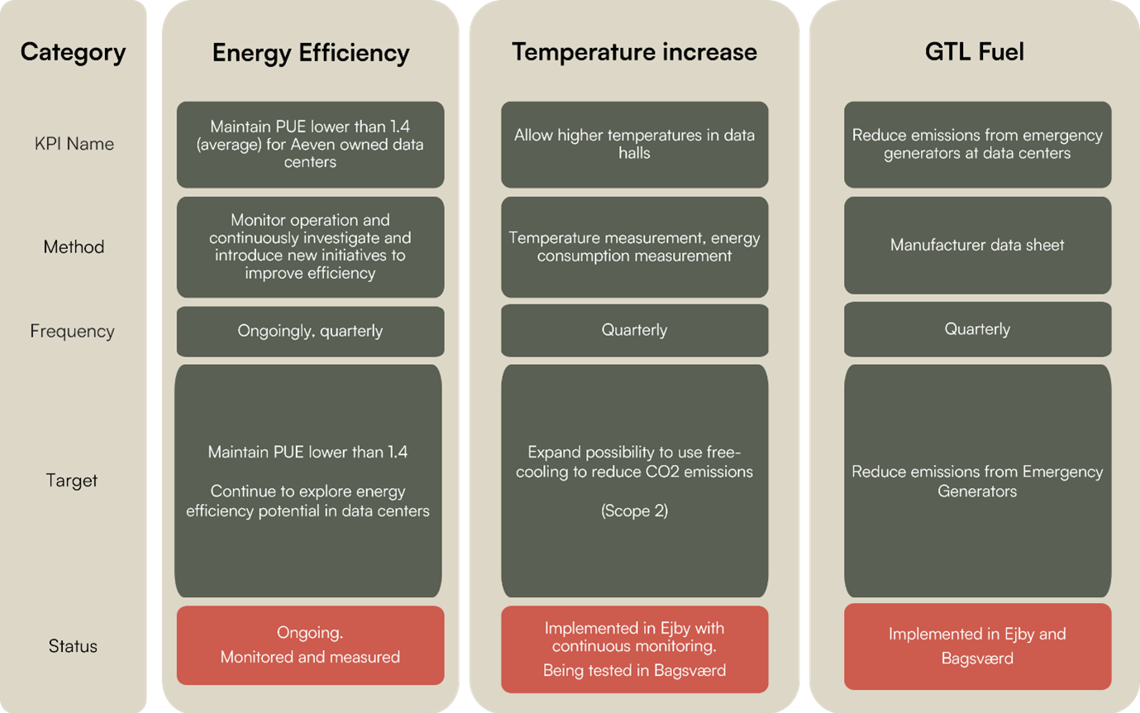Our role as a trusted partner to many Danish companies and public institutions comes with the responsibility to set high standards in sustainable efforts. We recognize the leverage we have to influence positive outcomes. This is why we're committed to being a leader in the changes we want to see.
As much as we have an impact on the climate, the climate too impacts our business. This is also known as the Double Materiality perspective. When operating within this context, we have set strategic goals to future-proof Aeven all the while taking our environmental impact into account.
To ensure our efforts are as effective as possible, we've conducted a thorough review of our business operations and set targets that reflect where we can have the most significant impact. Our environmental objectives span the categories of energy efficiency, temperature increase and GTL fuel.
How we plan to realize our environmental objectives
Maintaining PUE lower than 1,4
Improving PUE (Power Usage Effectiveness) is a long-term commitment, not a quick fix. As data center operators, we understand that meaningful enhancements to power usage effectiveness stem from implementing even minor adjustments like increasing the temperature in our server halls across our operations. These incremental changes, when combined, significantly reduce energy waste, improve PUE, and help us achieve our efficiency targets, demonstrating our ongoing commitment to responsible and sustainable data center management.
To realize our goal of maintaining an average annual PUE lower than 1,4, we are monitoring operation and continuously investigating and introducing new initiatives to improve efficiency.
Expanding the possibility to use free-cooling and reduce CO2 emissions
Status: Implemented in Ejby with continuous monitoring. Being tested in Bagsværd
The main source of electricity consumption in our data centers derives from operating our IT equipment, but our cooling systems are a significant contributor as well.
Keeping our customers' data safe and secure requires a considerable amount of energy, but there are ways to save energy without compromising operational quality in our data centers. By allowing higher temperatures in our server halls, we can rely less on compressor-based cooling in favor of free cooling. To reach our goal of expanding the use of free-cooling and thereby reduce CO2 emissions, we have tested and implemented a 3-degree temperature increase in our owned data centers. By doing so, we can save around 12 percent of the energy used for cooling down the server hall on average. Additionally, we ambitiously support our goal of maintaining an average annual PUE lower than 1,4.
To ensure an all-around positive environmental impact, we will continuously monitor if and how the increased temperature will affect hardware over time, taking life-cycle management into account.
Reducing emissions from Emergency Generators
Status: Implemented in Ejby and Bagsværd
As a responsible data center operator, we've made the decision to replace diesel fuel with GTL (Gas-to-Liquid) in our emergency generators, prioritizing both environmental responsibility and the health of our employees and communities. While GTL production requires more energy but slightly reduces CO2 emissions compared to diesel, its overall benefits make it the right choice for us.
GTL is produced from natural gas, a cleaner and less hazardous process than the extraction and refining of crude oil for diesel. This means fewer risks of land damage, water pollution, and harm to wildlife. Additionally, when GTL burns, it produces fewer harmful pollutants like sulfur and nitrogen compounds, which can contribute to respiratory issues and poor air quality. By using GTL, we're helping to create a cleaner and healthier environment around our facilities, protecting the well-being of those in and around our operations.
GTL also burns more efficiently, which leads to better performance and cleaner emissions from our generators. Although it’s more complex and costly to produce than diesel, the benefits of cleaner air and reduced environmental impact align with our commitment to sustainability.

